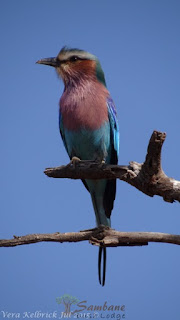The Lilac-breasted Roller is the national bird of Botswana
and Kenya.
While Western culture considers the dove as the bird of
peace, African culture considers the Lilac-breasted Roller as the bird of
peace. There are also some suggestions that the
Lilac-breasted Roller was first in line for God’s creation during His act of
creation. All the best colours were selected for this bird. God was so proud of
his new creation that He completely forgot to give His beautiful bird a
beautiful voice.
We have sighted many Lilac-breasted Rollers in our surrounds and we can almost 100% accurately say that these beautiful creatures are sighted daily in the Central Dinokeng area where we are situated.
Coracias caudatus (Lilac-breasted roller)
[= Coracias caudata]
Gewone troupant [Afrikaans]; iFefe (also applied to European roller) [Zulu]; Sikambu (generic term for roller) [Kwangali]; Matlakela [North Sotho]; Gatawa (generic name for roller) [Shona]; Vhevhe (generic term for roller) [Tsonga]; Letlêrêtlêrê, Letlhakêla [Tswana]; Vorkstaartscharrelaar [Dutch]; Rollier à longs brins [French]; Gabelracke [German]; Rolieiro-de-peito-lilás [Portuguese]
The lilac-breasted roller is often considered one of the most beautiful birds in the world with its pastel plumage, striking field marks and long tail streamers. More than one visitor in Africa searching for mammals leaves the continent a birder, naming this attractive species as their spark bird.
Appearance:- Bill: Large, thick, black, straight with a slight hook at the tip
- Size: 14-15 inches long with 20-23-inch wingspan, large head, short neck, forked tail with long, thin streamers on the outer feathers
- Colors: Buff, white, purple, blue, turquoise, green, black, tan
- Markings: Genders are similar with a white or creamy buff face with a dark eye line and prominent rictal bristles. The chin is white, auriculars are dark tan with a purple wash and the throat and upper breast are purple, most often a lilac shade but with some hue variation and darker shades lower on the body. The upper wings and back are tan, but the scapulars and primary feathers are rich, royal blue. The underparts are bright turquoise. The tail is blue with black outer streamers. In flight, the wings show a light blue patagium and wingpit contrasting strongly with a dark blue primary and secondary feathers. Legs and feet are greenish yellow.
Juveniles are dull overall with shades of brown and tan but develop adult colors quickly, though they lack the outer tail streamers.
Vocalizations:
These rollers have a harsh, raspy call that lasts less than a second but may be quickly repeated. The pitch does not vary, and the tone has a rattling quality. While mostly silent, they are more vocal during the breeding season or when they feel their territory is threatened.
Behavior:
These birds are typically solitary or are found in pairs, but may stay in small family groups during the winter months. They perch on high vantage points at the very tops of trees and poles, and stay still while watching for prey to approach. After dropping onto a victim, they may beat their prey against a rock or on the ground to kill it before swallowing it whole. All rollers, including the lilac-breasted, are known for their acrobatic, agile flight.
Attracting Lilac-Breasted Rollers:
These birds do not typically stay in areas near human habitation, but leaving isolated trees or poles available for tall perches can tempt them to visit. Where other nesting sites are scarce, they may use nesting boxes. In the field, they are unafraid when humans approach and it can be easy to get spectacular views.
Conservation:
These birds are not considered threatened or endangered, though habitat preservation can help keep their population numbers stable. Poaching for the pet trade is a minor threat.
Lilac-breasted rollers have uniquely adapted to one natural disaster – while brush fires can be devastating to many animals and birds, these rollers will deliberately hunt near the edges of fires where prey is fleeing and less wary of predators.
Source : http://birding.about.com/od/Dippers-Kingfishers/p/Lilac-Breasted-Roller.htm &
http://www.biodiversityexplorer.org/birds/coraciidae/coracias_caudatus.htm















